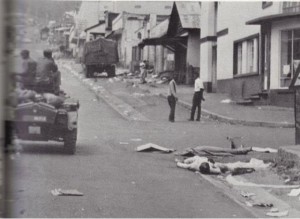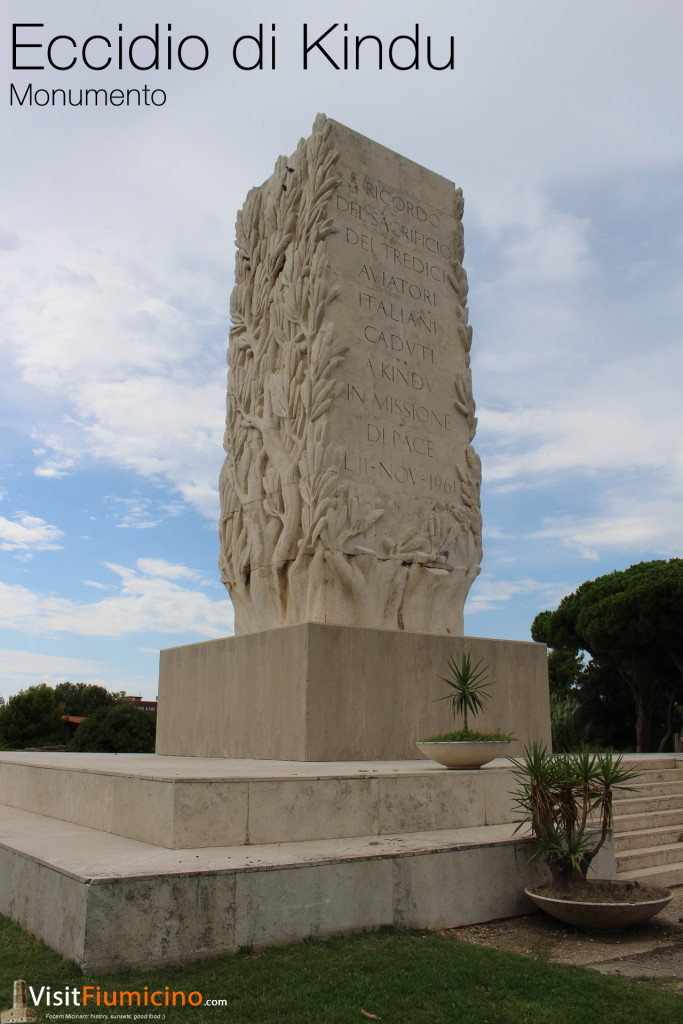
Near Fiumicino airport, next to the Museum and ship before take the Roma-Fiumicino, you may notice a big monument on a huge expanse of green lawn.
A large monument, towards the sky, collected in a series of white travertine, climbing carved on stone, that surround and envelop you in a fascinating blend of rock and nature. The sculpture is the work of Pio Manzù, sculptor and designer, son of the famous Giacomo Manzù.
This sculpture, so beautiful and impressive, hides a secret bloody and gory.
It is a stele in memory of a sacrifice in the name of peace.
 In 1961 the Congo was in the throes of a bloody civil war: Belgium, at the time of independence, left the Congo into a complete political and administrative chaos; large international and financial interests acted then to make the situation worse, by encouraging the secession of Katanga province, the richest province of the country, an important mining Center. The warring factions were three: that of President Joseph Kasa-Vubu with troops commanded by General Mobutu who controlled the western regions, that of lumumbista Antoine Gizenga with troops of General Lundula who controlled the eastern provinces, and the katanghese of Moise Tshombe with gendarmes led by white mercenaries, especially Belgians.
In 1961 the Congo was in the throes of a bloody civil war: Belgium, at the time of independence, left the Congo into a complete political and administrative chaos; large international and financial interests acted then to make the situation worse, by encouraging the secession of Katanga province, the richest province of the country, an important mining Center. The warring factions were three: that of President Joseph Kasa-Vubu with troops commanded by General Mobutu who controlled the western regions, that of lumumbista Antoine Gizenga with troops of General Lundula who controlled the eastern provinces, and the katanghese of Moise Tshombe with gendarmes led by white mercenaries, especially Belgians.
A massive UN military intervention will unleash even more the situation, with the Secretary-General of the United Nations that will fall victim to an attack in November.
In this context so bloody delicate Italy also does its part by sending a contingent of two plane C119 of the Italian air force with u.n. symbols that are mandated to supply the small Malaysian United Nations garrison controlling the airport not far from Kindu, on the edge of the equatorial forest. The area was devastated by months of the passage of the troops of Gizenga from Stanleyville and in Katanga, improvised units whose members were often drunk, unruly and engaged in robberies against local population; on 25 September Raffaele Soru had died earlier, a volunteer of the military corps of the Italian Red Cross was mortally wounded just in Kindu during clashes between rebels and soldiers.
On the morning of Saturday November 11, 1961 the two planes were launched from the capital Leopoldville to bring supply to the small Malaysian United Nations garrison.
 Italian planes were stopping in Kindu for just as long to download and, for crews, something to eat. The two C-119 appeared in the sky of the city shortly after the 14:00, and after doing a few turns above the village landed at the airport controlled by Malaysians. For several days there was a greater than usual: agitation among the 2,000 Congolese soldiers in Kindu had spread the rumor that a launch was imminent of parachutists hired mercenaries of Tshombe's regime, and Gizenga's troops operating in northern Katanga province, 500 kilometers south of Kindu, were subjected to bombing from planes by Katangese troops.
Italian planes were stopping in Kindu for just as long to download and, for crews, something to eat. The two C-119 appeared in the sky of the city shortly after the 14:00, and after doing a few turns above the village landed at the airport controlled by Malaysians. For several days there was a greater than usual: agitation among the 2,000 Congolese soldiers in Kindu had spread the rumor that a launch was imminent of parachutists hired mercenaries of Tshombe's regime, and Gizenga's troops operating in northern Katanga province, 500 kilometers south of Kindu, were subjected to bombing from planes by Katangese troops.
The sight of two Italian planes mistaken for aircraft, parachute loads katangans unleashed uncontrolled reaction of soldiers stationed in Kindu: several hundred Congolese went by truck to the airport where at that time the thirteen men Italian crew, commanded by major Parmeggiani, stood at the table of the UN, a House which is a kilometre from the runway, along with a dozen officers of the Malaysian garrison. Around 16:15 the Congolese raided the building, where Italians and Malaysians, almost all unarmed, had barricaded themselves: about 80 Congolese soldiers quickly overwhelmed the occupants of the building and malmenarono them harshly, by persevering in particular against Italians exchanged for Belgian mercenaries in the pay of the katangans. Lieutenant doctor Francesco Paolo Remotti tried to flee by leaping from a window, but was quickly joined by Congolese and immediately killed.
Around 300 other militiamen arrived 16:30 Congo led by Commander of the garrison at Kindu, a Colonel Pakassa: Malay, Commander major Maud, tried in vain to convince him that the airmen were Italian and UN 16:50 the twelve Italians, forced to carry with them the body of Rad, were loaded onto trucks and taken power in town, only to be locked in small local prison. While major Maud and his Deputy discussing whether it was better to treat peaceful release of Italians or attempt to force action to free them, that night they arrived at the airport of Kindu from Leopoldville General Lundula and some officials of the ONUC: the Group sought to contact the presidio command to start a channel of negotiations, but the attempt failed and had the general impression that Congolese officials had now lost all control over their men.
That night, Congolese soldiers stormed into the cell where the twelve airmen were detained Italians and killed them all with machine guns; bodies abandoned in place, these were moved a few hours later by the keeper of the prison, fearing that the havoc, transported them by truck in the forest outside the city and buried them in a mass grave.
 For days he learned nothing about the fate of the airmen, and the same command of UN troops to avoid temporeggiò triggering retaliation against Italians without knowing that these had already been killed. Only a few weeks after the massacre the keeper of the prison made contact with brothers Abdulkareem, two Italians living in Kindu: these were able to reconstruct the circumstances of the massacre and UN authorities to arrange recovery of remains. In February 1962 and then an Austrian Red Cross convoy, escorted by a contingent of Ethiopian peacekeepers and accompanied by two officers of the 46th Brigata Aerea (Lieutenant Colonel Pantoja and Maj. Parker), uncovered the mass grave where they were buried in the cemetery of the Italian Tokolote, a small village on the banks of the Lualaba River on the edge of the forest: the bodies , protected by a thick crust of clay, were still in good condition and were easily identified. Transported to the airport of Kindu, they boarded a C-119 and Italian sent to Leopoldville, from where they returned in Italy aboard a C-130 in the United States.
For days he learned nothing about the fate of the airmen, and the same command of UN troops to avoid temporeggiò triggering retaliation against Italians without knowing that these had already been killed. Only a few weeks after the massacre the keeper of the prison made contact with brothers Abdulkareem, two Italians living in Kindu: these were able to reconstruct the circumstances of the massacre and UN authorities to arrange recovery of remains. In February 1962 and then an Austrian Red Cross convoy, escorted by a contingent of Ethiopian peacekeepers and accompanied by two officers of the 46th Brigata Aerea (Lieutenant Colonel Pantoja and Maj. Parker), uncovered the mass grave where they were buried in the cemetery of the Italian Tokolote, a small village on the banks of the Lualaba River on the edge of the forest: the bodies , protected by a thick crust of clay, were still in good condition and were easily identified. Transported to the airport of Kindu, they boarded a C-119 and Italian sent to Leopoldville, from where they returned in Italy aboard a C-130 in the United States.
In 1994 it was recognized to their memory the Medaglia d'Oro al Valore Militare; only in 2007 relatives of victims obtained a law on compensation. A monument to the fallen of Kindu is located at the entrance to the international airport Leonardo da Vinci in Fiumicino; Another was erected in Pisa.
Monument on the stele of Fiumicino there is written in large letters,
“To commemorate the sacrifice of the 13 Italian aviators fallen in Kindu in the peace mission November 11, 1961“.
After the massacre, pilots and flight attendants, Alitalia's men claimed that their uniform was a black tie in place of the previous blue, in sign of mourning for the slain Airmen 13. However, in June the leadership 2015 Alitalia, in the context of renewal of the company's image, decided to replace the flight attendants ' tie with a livelier imagination regimental, while the pilots continue to wear the traditional black tie service revolver.
The aviators were killed: 13